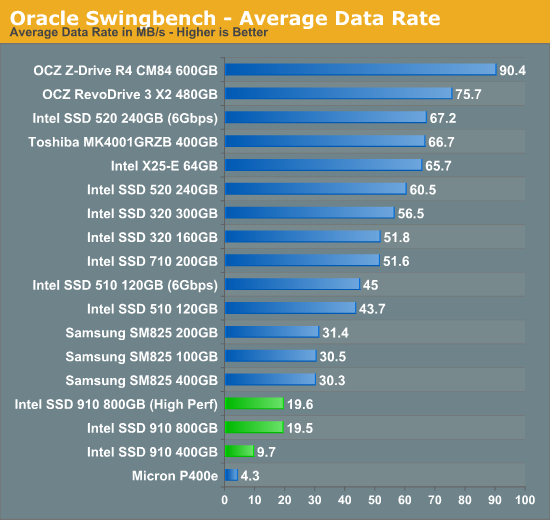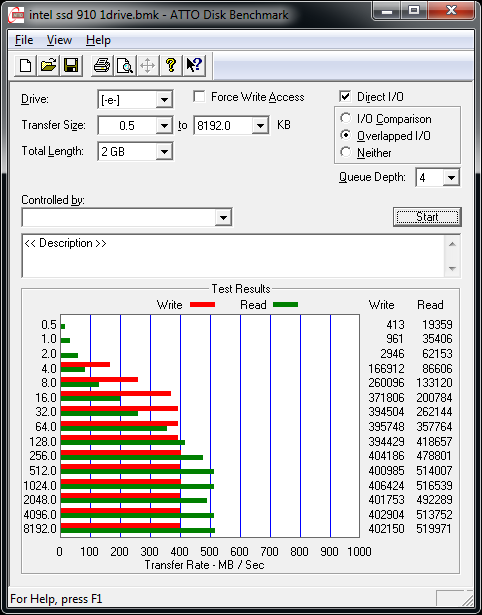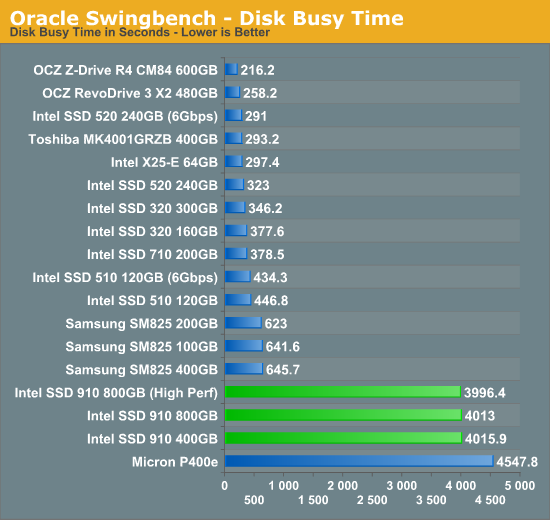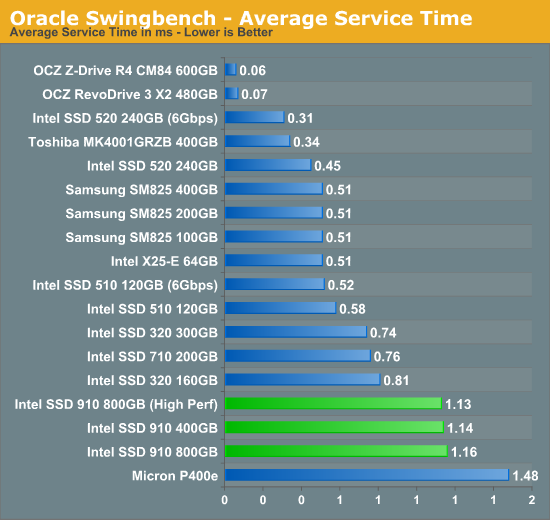The Intel SSD 910 Review
by Anand Lal Shimpi on August 9, 2012 1:00 PM EST- Posted in
- Storage
- SSDs
- Intel
- Intel SSD 910
Enterprise Storage Bench - Oracle Swingbench
We begin with a popular benchmark from our server reviews: the Oracle Swingbench. This is a pretty typical OLTP workload that focuses on servers with a light to medium workload of 100 - 150 concurrent users. The database size is fairly small at 10GB, however the workload is absolutely brutal.
Swingbench consists of over 1.28 million read IOs and 3.55 million writes. The read/write GB ratio is nearly 1:1 (bigger reads than writes). Parallelism in this workload comes through aggregating IOs as 88% of the operations in this benchmark are 8KB or smaller. This test is actually something we use in our CPU reviews so its queue depth averages only 1.33. We will be following up with a version that features a much higher queue depth in the future.

The 910 absolutely suffers through our Swingbench test, performing worse than a single Intel SSD 710. The explanation is pretty simple, small file, low queue depth IO is very slow on the 910. Running ATTO on a single 910 partition tells us everything we need to know:

Look at the small file write performance here. At 0.5KB a single 910 partition can only write at 413KB/s. Performance doesn't actually scale up until we hit 4KB transfers on the write side. I suspect this has a lot to do with why we're seeing poor performance here.












39 Comments
View All Comments
lorribot - Thursday, August 9, 2012 - link
I like the idea but coming from a highly redundant arrays point of view how do you set this all up in a a safe and secure way, what are the points of failure? what happens if you lose the bridge chip, is all your data dead and buried?Would you be looking to put say 3 of these cards in a server and software raid 5 across the cards for multiple disks?
No hardware raid solution will work across multiple PCI-e cards so there really needs to be some work in how to manage all this in a sensible way needs to be done.
I doubt any one in an Enterprise would stick one of these in a server and use it as primary storage for their SAP database it is way too risky a proposition.
What would be good is a 3 1/5 format drive with a fibre channel interface that could work in existing storage solutions.
FunBunny2 - Thursday, August 9, 2012 - link
-- What would be good is a 3 1/5 format drive with a fibre channel interface that could work in existing storage solutions.If memory serves, that's what STEC made and hasn't been all that profitable.
Guspaz - Thursday, August 9, 2012 - link
At the end of the first page, "performnace"happycamperjack - Thursday, August 9, 2012 - link
Wouldn't it be more fair to compare it to a 800 gb CM88 R4 since it's around the same capacity and price as the intel 910 and quite a bit faster.Elixer - Thursday, August 9, 2012 - link
What happens when it is over 60% full on these things ? I am betting a huge drop off in speed, just like the desktop parts.MrSpadge - Sunday, August 12, 2012 - link
Probably not, since they're >50% overprovisioned.Jammrock - Thursday, August 9, 2012 - link
I would like to see some Fusion-IO tests. They are generally considered the highest end in enterprise SSDs. I've played with some in the past and they were crazy fast and reliable.puffpio - Friday, August 10, 2012 - link
agreed..any thoughts on a heads up between this and a similar capacity fusion io iodrive2?happycamperjack - Friday, August 10, 2012 - link
http://hothardware.com/Reviews/Intel-SSD-910-PCI-E...hmmmmmm - Saturday, August 11, 2012 - link
unfortunately, they are comparing the 910 to a 2009, discontinued card from fusion-io. would like to see a new card in the comparison to be able to compare what's on the market today